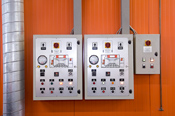
|
|
PLC process control

Have you ever wondered how measurement devices such as thermostats work? How does the thermostat measure the room temperature and then make the necessary changes so that your furnace or air conditioner suddenly turns on or off? This would seem to be an almost magical process. Thanks to brilliant engineers working for years we now have what are known as programmable logic controllers (PLC) that measure and adjust machines, and many different types of machines. Beyond your PLC thermostat there are very important applications for a PLC in manufacturing. As you can imagine, there are several complicated processes that use a PLC to monitor and change the way that they work. Think about a manufacturing process, for example, that requires some sort of raw material input. If the inputs came to frequently or not frequently enough the process can encounter serious problems. Things at both the input and output end of the production line need to be closely monitored in connection with each other.
|
|
There are a couple of different parts of a PLC or process control system. One is the controlled variable which is the input coming into the system. This is the variable used to make decisions about the remainder of the process-the foundation for all other changes. The next variable is the set point, which is the desired level of production. There is also a manipulable variable that can be used to change the the process. In the example of a complex manufacturing process this would, for example, be the conveyor that brings in raw material to a furnace or mold injector. It is the variable that can be changed to bring the process up to the desired set point.
PLC are complex devices that interpret information in the form of digital or analog inputs and thenuse some basic program or system to read them. The PLC then uses its programing to determine what needs to be done for the process to reach its appropriate levels. The PLC is programmed to take in various situations so that the system can change quickly according to the given conditions. If the PLC cannot make changes quickly it is no good. However, a PLC is a much more precise way to control a process than through a manual control. Trying to constantly gage what to put in or take out of system takes time and is often inneficient.
Regardless of what type of manufacturing you are planning to do, a PLC of some sort will be very important. The wonder of modern manufacturing is that machines are able to allow us to do far less work and produce a great deal more. A PLC is of tremendous importance for making this system work. Regardless of whether you are building a robotic line or if you are working on a batch manufacturing line, the PLC should provide you with the control needed to keep your process going continuously and successfully.
PLC for major manufacturing are naturally not very cheap. They are one of the most important parts of any manufacturing process, and they require skilled engineers to install and manage. Before you invest in any form of new manufacturing consider the PLC device or program that will enable you to continue producing quality goods at the appropriate levels. A poorly functioning PLC can be the death of a business. Imagine your thermostat going haywire in a room and producing too little or too much heat. A good PLC is a basic ingredient of success in almost any process that requires constant input and output control.
Privacy Policy, Terms of Use